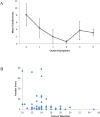Increased generalization of learned associations is related to re-experiencing symptoms in veterans with symptoms of post-traumatic stress
- PMID: 26372003
- PMCID: PMC4583812
- DOI: 10.3109/10253890.2015.1053450
Increased generalization of learned associations is related to re-experiencing symptoms in veterans with symptoms of post-traumatic stress
Abstract
One interpretation of re-experiencing symptoms in post-traumatic stress disorder (PTSD) is that memories related to emotional information are stored strongly, but with insufficient specificity, so that stimuli which are minimally related to the traumatic event are sufficient to trigger recall. If so, re-experiencing symptoms may reflect a general bias against encoding background information during a learning experience, and this tendency might not be limited to learning about traumatic or even autobiographical events. To test this possibility, we administered a discrimination-and-transfer task to 60 Veterans (11.2% female, mean age 54.0 years) self-assessed for PTSD symptoms in order to examine whether re-experiencing symptoms were associated with increased generalization following associative learning. The discrimination task involved learning to choose the rewarded object from each of six object pairs; each pair differed in color or shape but not both. In the transfer phase, the irrelevant feature in each pair was altered. Regression analysis revealed no relationships between re-experiencing symptoms and initial discrimination learning. However, re-experiencing symptom scores contributed to the prediction of transfer performance. Other PTSD symptom clusters (avoidance/numbing, hyperarousal) did not account for significant additional variance. The results are consistent with an emerging interpretation of re-experiencing symptoms as reflecting a learning bias that favors generalization at the expense of specificity. Future studies will be needed to determine whether this learning bias may pre-date and confer risk for, re-experiencing symptoms in individuals subsequently exposed to trauma, or emerges only in the wake of trauma exposure and PTSD symptom development.
Keywords: Anxiety; associative learning; declarative memory; stress; transfer; veterans.
Conflict of interest statement
The authors affirm that they have no relationships that could constitute potential conflict of interest.
Figures



Similar articles
-
Post-traumatic stress disorder symptom burden and gender each affect generalization in a reward- and punishment-learning task.PLoS One. 2017 Feb 14;12(2):e0172144. doi: 10.1371/journal.pone.0172144. eCollection 2017. PLoS One. 2017. PMID: 28196108 Free PMC article.
-
Acquired equivalence in U.S. veterans with symptoms of posttraumatic stress: reexperiencing symptoms are associated with greater generalization.J Trauma Stress. 2014 Dec;27(6):717-20. doi: 10.1002/jts.21974. Epub 2014 Dec 2. J Trauma Stress. 2014. PMID: 25470729 Free PMC article.
-
Differential predictive value of PTSD symptom clusters for mental health care among Iraq and Afghanistan veterans following PTSD diagnosis.Psychiatry Res. 2017 Oct;256:32-39. doi: 10.1016/j.psychres.2017.06.005. Epub 2017 Jun 14. Psychiatry Res. 2017. PMID: 28622572
-
Intrusive re-experiencing in post-traumatic stress disorder: phenomenology, theory, and therapy.Memory. 2004 Jul;12(4):403-15. doi: 10.1080/09658210444000025. Memory. 2004. PMID: 15487537 Review.
-
The incorporation of emotion-regulation skills into couple- and family-based treatments for post-traumatic stress disorder.Mil Med Res. 2017 Jun 30;4:21. doi: 10.1186/s40779-017-0130-9. eCollection 2017. Mil Med Res. 2017. PMID: 28680693 Free PMC article. Review.
Cited by
-
A universal hippocampal memory code across animals and environments.bioRxiv [Preprint]. 2025 Jun 3:2024.10.24.620127. doi: 10.1101/2024.10.24.620127. bioRxiv. 2025. PMID: 39484538 Free PMC article. Preprint.
-
On the Complexity of Brain Disorders: A Symptom-Based Approach.Front Comput Neurosci. 2016 Feb 23;10:16. doi: 10.3389/fncom.2016.00016. eCollection 2016. Front Comput Neurosci. 2016. PMID: 26941635 Free PMC article.
-
Generalization of Conscious Fear Is Positively Correlated with Anxiety, but Not with Depression.Exp Neurobiol. 2018 Feb;27(1):34-44. doi: 10.5607/en.2018.27.1.34. Epub 2018 Feb 22. Exp Neurobiol. 2018. PMID: 29535568 Free PMC article.
-
Post-traumatic stress disorder symptom burden and gender each affect generalization in a reward- and punishment-learning task.PLoS One. 2017 Feb 14;12(2):e0172144. doi: 10.1371/journal.pone.0172144. eCollection 2017. PLoS One. 2017. PMID: 28196108 Free PMC article.
-
Neural Correlates of Outcome of the Psychotherapy Compared to Antidepressant Therapy in Anxiety and Depression Disorders: A Meta-Analysis.Front Psychol. 2017 Jun 7;8:927. doi: 10.3389/fpsyg.2017.00927. eCollection 2017. Front Psychol. 2017. PMID: 28638359 Free PMC article. Review.
References
-
- Blanchard EB, Jones-Alexander J, Buckley TC, Forneris CA. Psychometric properties of the PTSD checklist (PCL) Behavioral Research and Therapy. 1996;34(8):669–673. - PubMed
-
- Brewin CR. Episodic memory, perceptual memory, and their interaction: Foundations for a theory of posttraumatic stress disorder. Psychological Bulletin. 2014;140(1):69–97. - PubMed
-
- Brewin CR, Andrews B, Valentine JD. Meta-analysis of risk factors for posttraumatic stress disorder in trauma-exposed adults. Journal of Consulting and Clinical Psychology. 2000;68(5):748–766. - PubMed
-
- Brown JM, Williams J, Bray RM, Hourani L. Postdeployment alcohol use, aggression, and post-traumatic stress disorder. Military Medicine. 2012;177(10):1184–1190. - PubMed
Publication types
MeSH terms
Grants and funding
LinkOut - more resources
Full Text Sources
Other Literature Sources
Medical
